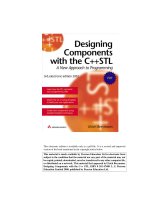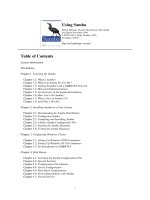OReilly designing interfaces nov 2005 ISBN 0596008031
Bạn đang xem bản rút gọn của tài liệu. Xem và tải ngay bản đầy đủ của tài liệu tại đây (8.67 MB, 677 trang )
DesigningInterfaces
ByJeniferTidwell
...............................................
Publisher:O'Reilly
PubDate:November2005
PrintISBN-10:0-596-00803-1
PrintISBN-13:978-0-59-600803-1
Pages:352
TableofContents|Index
Designingagoodinterfaceisn'teasy.Usersdemandsoftwarethatiswell-behaved,goodlooking,andeasytouse.Yourclientsormanagersdemandoriginalityandashorttimeto
market.YourUItechnology--Webapplications,desktopsoftware,evenmobiledevices-maygiveyouthetoolsyouneed,butlittleguidanceonhowtousethemwell.
UIdesignersovertheyearshaverefinedtheartofinterfacedesign,evolvingmanybest
practicesandreusableideas.Ifyoulearnthese,andunderstandwhythebestuser
interfacesworksowell,youtoocandesignengagingandusableinterfaceswithless
guessworkandmoreconfidence.
DesigningInterfacescapturesthosebestpracticesasdesignpatterns--solutionsto
commondesignproblems,tailoredtothesituationathand.Eachpatterncontainspractical
advicethatyoucanputtouseimmediately,plusavarietyofexamplesillustratedinfull
color.You'llgetrecommendations,designalternatives,andwarnings
onwhennottousethem.
Eachchapter'sintroductiondescribeskeydesignconceptsthatareoftenmisunderstood,
suchasaffordances,visualhierarchy,navigationaldistance,andtheuseofcolor.These
giveyouadeeperunderstandingofwhythepatternswork,andhowtoapplythemwith
moreinsight.
Abookcan'tdesignaninterfaceforyou--nofoolproofdesignprocessisgivenhere--but
DesigningInterfacesdoesgiveyouconcreteideasthatyoucanmixandrecombineasyou
seefit.Experienceddesignerscanuseitasasourcebookofideas.Novicedesignerswill
findaroadmaptotheworldofinterfaceandinteractiondesign,withenoughguidanceto
startusingthesepatternsimmediately.
DesigningInterfaces
ByJeniferTidwell
...............................................
Publisher:O'Reilly
PubDate:November2005
PrintISBN-10:0-596-00803-1
PrintISBN-13:978-0-59-600803-1
Pages:352
TableofContents|Index
Copyright
Preface
SMALLINTERFACEPIECES,LOOSELYJOINED
ABOUTPATTERNSINGENERAL
OTHERPATTERNCOLLECTIONS
ABOUTTHEPATTERNSINTHISBOOK
AUDIENCE
HOWTHISBOOKISORGANIZED
COMMENTSANDQUESTIONS
ACKNOWLEDGMENTS
Chapter1.WhatUsersDo
Section1.1.AMEANSTOANEND
Section1.2.THEBASICSOFUSERRESEARCH
Section1.3.USERS'MOTIVATIONTOLEARN
Section1.4.THEPATTERNS
Chapter2.OrganizingtheContent:InformationArchitectureandApplication
Structure
Section2.1.THEBASICSOFINFORMATIONARCHITECTURE:DIVIDING
STUFFUP
Section2.2.PHYSICALSTRUCTURE
Section2.3.THEPATTERNS
Chapter3.GettingAround:Navigation,Signposts,andWayfinding
Section3.1.STAYINGFOUND
Section3.2.THECOSTOFNAVIGATION
Section3.3.THEPATTERNS
Chapter4.OrganizingthePage:LayoutofPageElements
Section4.1.THEBASICSOFPAGELAYOUT
Section4.2.THEPATTERNS
Chapter5.DoingThings:ActionsandCommands
Section5.1.PUSHINGTHEBOUNDARIES
Section5.2.THEPATTERNS
Chapter6.ShowingComplexData:Trees,Tables,andOtherInformationGraphics
Section6.1.THEBASICSOFINFORMATIONGRAPHICS
Section6.2.THEPATTERNS
Chapter7.GettingInputfromUsers:FormsandControls
Section7.1.THEBASICSOFFORMDESIGN
Section7.2.CONTROLCHOICE
Section7.3.THEPATTERNS
Chapter8.BuildersandEditors
Section8.1.THEBASICSOFEDITORDESIGN
Section8.2.THEPATTERNS
Chapter9.MakingItLookGood:VisualStyleandAesthetics
Section9.1.SAMECONTENT,DIFFERENTSTYLES
Section9.2.THEBASICSOFVISUALDESIGN
Section9.3.WHATTHISMEANSFORDESKTOPAPPLICATIONS
Section9.4.THEPATTERNS
AbouttheAuthor
Colophon
Index
Copyright©2006O'ReillyMedia,Inc.Allrightsreserved.
PrintedintheUnitedStatesofAmerica.
PublishedbyO'ReillyMedia,Inc.,1005GravensteinHighway
North,Sebastopol,CA95472.
O'Reillybooksmaybepurchasedforeducational,business,or
salespromotionaluse.Onlineeditionsarealsoavailablefor
mosttitles(safari.oreilly.com).Formoreinformation,contact
ourcorporate/institutionalsalesdepartment:(800)998-9938or
Editors:
AndrewOdewahnandMaryO'Brien
ProductionEditor:
Genevieved'Entremont
CoverDesigner:
MikeKohnke
InteriorDesigner:
NOON
PrintingHistory:
November2005:
FirstEdition.
NutshellHandbook,theNutshellHandbooklogo,andthe
O'ReillylogoareregisteredtrademarksofO'ReillyMedia,Inc.
DesigningInterfacesandrelatedtradedressaretrademarksof
O'ReillyMedia,Inc.
Manyofthedesignationsusedbymanufacturersandsellersto
distinguishtheirproductsareclaimedastrademarks.Where
thosedesignationsappearinthisbook,andO'ReillyMedia,Inc.,
wasawareofatrademarkclaim,thedesignationshavebeen
printedincapsorinitialcaps.
Whileeveryprecautionhasbeentakeninthepreparationofthis
book,thepublisherandauthorassumenoresponsibilityfor
errorsoromissions,orfordamagesresultingfromtheuseof
theinformationcontainedherein.
ThisbookusesRepKover,adurableandflexiblelay-flatbinding.
ISBN:0-596-00803-1
[C]
Preface
Onceuponatime,interfacedesignersworkedwithawoefully
smalltoolbox.
Wehadahandfulofsimplecontrols:textfields,buttons,
menus,tinyicons,andmodaldialogs.Wecarefullyputthem
togetheraccordingtotheWindowsStyleGuideortheMacintosh
HumanInterfaceGuidelines,andwehopedthatuserswould
understandtheresultinginterfaceandtoooften,theydidn't.We
designedforsmallscreens,fewcolors,slowCPUs,andslow
networks(iftheuserwasconnectedatall).Wemadethem
gray.
Thingshavechanged.Ifyoudesigninterfacestoday,youwork
withamuchbiggerpaletteofcomponentsandideas.Youhave
achoiceofmanymoreuserinterfacetoolkitsthanbefore,such
asJava™Swing,Qt,HTMLandJavascript,Flash,andnumerous
open-sourceoptions.Apple'sandMicrosoft'snativeUItoolkits
arericherandnicer-lookingthantheyusedtobe.Display
technologyisbetter.Webapplicationsoftenlookas
professionallydesignedasthewebsitesthey'reembeddedin,
andwhiledesktop-UIideaslikedrag-and-dropareintegrated
intowebapplicationsslowly,someofthosewebsensibilitiesare
migratingbackintodesktopapplicationsintheformofblue
underlinedlinks,Back/Nextbuttons,daringfontsand
backgroundimages,andnice,non-graycolorschemes.
Butit'sstillnoteasytodesigngoodinterfaces.Let'ssayyou're
notatrainedorself-taughtinterfacedesigner.Ifyoujustuse
theUItoolkitsthewaytheyshouldbeused,andifyoufollow
thevariousstyleguidesorimitateexistingapplications,youcan
probablycreateamediocrebutpassableinterface.
Alas,thatmaynotbeenoughanymore.Users'expectationsare
higherthantheyusedtobeifyourinterfaceisn'teasytouse
"outofthebox,"userswillnotthinkwellofit.Evenifthe
interfaceobeysallthestandards,youmayhavemisunderstood
users'preferredworkflow,usedthewrongvocabulary,ormade
ittoohardtofigureoutwhatthesoftwareevendoes.Impatient
usersoftenwon'tgiveyouthebenefitofthedoubt.Worse,if
you'vebuiltanunusablewebsiteorwebapplication,frustrated
userscangiveupandswitchtoyourcompetitorwithjustthe
clickofabutton.Sothecostofbuildingamediocreinterfaceis
higherthanitusedtobe,too.
It'seventougherifyoudesignproductsoutsideofthedesktop
andwebworlds,becausethere'sverylittlegooddesignadvice
outthere.Palmtops,cellphones,carnavigationsystems,digital
TVrecordersdesignersarestillfiguringoutwhatworksand
whatdoesn't,oftenfrombasicprinciples.(Andtheirusersoften
toleratedifficultinterfacesbutthatwon'tlastlong.)
Deviceslikephones,TVs,andcardashboardsoncewerethe
exclusivedomainofindustrialdesigners.Butnowthosedevices
havebecomesmart.Increasinglypowerfulcomputersdrive
them,andsoftware-basedfeaturesandapplicationsare
multiplyinginresponsetomarketdemands.They'rehereto
stay,whetherornottheyareeasytouse.Atthisrate,good
interfaceandinteractiondesignmaybetheonlyhopeforour
collectivesanityin10years.
SMALLINTERFACEPIECES,LOOSELYJOINED
Asaninterfacedesignertryingtomakesenseofallthe
technologychangesinthelastfewyears,Iseetwobigeffects
onthecraftofinterfacedesign.Oneistheproliferationof
interfaceidioms:recognizabletypesorstylesofinterfaces,each
withitsownvocabularyofobjects,actions,andvisuals.You
probablyrecognizealltheonesshowninthefigureonthenext
page,andmorearebeinginventedallthetime.
FigureI-1.Asamplerofinterfaceidioms
Thesecondeffectisalooseningoftherulesforputtingtogether
interfacesfromtheseidioms.Itnolongersurprisesanyoneto
seeseveraloftheseidiomsmixedupinoneinterface,for
instance,ortoseepartsofsomecontrolsmixedupwithparts
ofothercontrols.Onlinehelppages,whichhavelongbeen
formattedinhypertextanyway,mightnowhaveinteractive
appletsinthem,animations,orlinkstoaweb-basedbulletin
board.Interfacesthemselvesmighthavehelptextsonthem,
interleavedwithformsoreditors;thisusedtoberare.Combo
boxes'dropdownmenusmighthavefunkylayouts,likecolor
gridsorsliders,insteadofthestandardcolumnoftextitems.
Youmightseewebapplicationsthatlooklikedocumentcenteredpaintprograms,buthavenomenubars,andsavethe
finishedworkonlytoadatabasesomewhere.
Thefreeform-nessofwebpagesseemstohavetaughtusersto
relaxtheirexpectationswithrespecttographicsand
interactivity.It'sokaynowtobreaktheoldWindowsstyleguide
strictures,aslongasuserscanfigureoutwhatyou'redoing.
Andthat'sthehardpart.Someapplications,devices,andweb
applicationsareeasytouse.Manyaren't.Followingstyleguides
neverguaranteedusabilityanyhow,butnowdesignershave
evenmorechoicesthanbefore(which,paradoxically,canmake
designalotharder).Whatcharacterizesinterfacesthatare
easytouse?
Onecouldsay,"Theapplicationsthatareeasytouseare
designedtobeintuitive."Well,yes.That'salmostatautology.
Exceptthattheword"intuitive"isalittlebitdeceptive.Jef
Raskinoncepointedoutthatwhenwesay"intuitive"inthe
contextofsoftware,wereallymean"familiar."Computermice
aren'tintuitivetosomeonewho'sneverseenone(thougha
growlinggrizzlybearwouldbe).There'snothinginnateor
instinctiveinthehumanbraintoaccountforit.Butonceyou've
taken10secondstolearntouseamouse,it'sfamiliar,and
you'llneverforgetit.Sameforblueunderlinedtext,play/pause
buttons,andsoon.
Rephrased:"Theapplicationsthatareeasytousearedesigned
tobefamiliar."
Nowwe'regettingsomewhere."Familiar"doesn'tnecessarily
meanthateverythingaboutagivenapplicationisidenticalto
somegenre-definingproduct(e.g.,Word,Photoshop,MacOS,
oraWalkman).Peoplearesmarterthanthat.Aslongasthe
partsarerecognizableenough,andtherelationshipsamongthe
partsareclear,thenpeoplecanapplytheirpreviousknowledge
toanovelinterfaceandfigureitout.
That'swherepatternscomein.Thisbookcatalogsmanyof
thosefamiliarparts,inwaysyoucanreuseinmanydifferent
contexts.Patternscaptureacommonstructureusuallyavery
"local"one,likefunkylayoutsonacomboboxwithoutbeingtoo
concreteonthedetails,whichgivesyouflexibilitytobe
creative.
Ifyouknowwhatusersexpectofyourapplication,andifyou
choosecarefullyfromyourtoolboxofidioms(large-scale),
controls(small-scale),andpatterns(coveringtherange),then
youcanputtogethersomethingwhich"feelsfamiliar"while
remainingoriginal.
Andthatgetsyouthebestofbothworlds.
ABOUTPATTERNSINGENERAL
Inessence,patternsarestructuralandbehavioralfeaturesthat
improvethe"habitability"ofsomethingauserinterface,aweb
site,anobject-orientedprogram,orevenabuilding.Theymake
thingseasiertounderstandormorebeautiful;theymaketools
moreusefulandusable.
Assuch,patternscanbeadescriptionofbestpracticeswithina
givendesigndomain.Theycapturecommonsolutionstodesign
tensions(usuallycalled"forces"inpatternliterature)andthus,
bydefinition,arenotnovel.Theyaren'toff-the-shelf
components;eachimplementationofapatterndiffersalittle
fromeveryother.Theyaren'tsimplerulesorheuristicseither.
Andtheywon'twalkyouthroughanentiresetofdesign
decisionsifyou'relookingforacompletestep-by-step
descriptionofhowtodesignaninterface,apatterncatalogisn't
theplace!
Thisbookdescribespatternsliterallyassolutionstodesign
problemsbecausepartoftheirvalueliesinthewaythey
resolvetensionsinvariousdesigncontexts.Forinstance,an
interfacedesignerwhoneedstopackalotofstuffintoatoosmallspacecanuseaCardStack.Whatremainsforthe
designerisinformationarchitecturehowtosplitupthecontent
intopieces,whattonamethem,etc.andwhatexactlytheCard
Stackwilllooklikewhenit'sdone.Tabs?Alefthand-sidelistor
tree?That'suptothedesigner'sjudgment.
Someverycompletesetsofpatternsmakeupa"pattern
language."Thesepatternsresemblevisuallanguages,inthat
theycovertheentirevocabularyofelementsusedinadesign
(thoughpatternlanguagesaremoreabstractandbehavioral;
visuallanguagestalkaboutshapes,icons,colors,fonts,etc.).
Thissetisn'tnearlysocomplete,anditcontainstechniquesthat
don'tqualifyastraditionalpatterns.Butit'sconciseenoughto
bemanageableanduseful.
OTHERPATTERNCOLLECTIONS
Thetextthatstarteditalldealtwithphysicalbuildings,not
software.ChristopherAlexander'sAPatternLanguage,andits
companionbook,TheTimelessWayofBuilding(bothOxford
UniversityPress),establishedtheconceptofpatternsand
describeda250-patternmultilayeredpatternlanguage.Itis
oftenconsideredthegoldstandardforapatternlanguage
becauseofitscompleteness,itsrichinterconnectedness,andits
groundinginthehumanresponsetoourbuiltworld.
Inthemid-1990s,thepublicationofDesignPatterns,(AddisonWesley)byErichGamma,RichardHelm,RalphJohnson,and
JohnVlissidesprofoundlychangedthepracticeofcommercial
softwarearchitecture.Thisbookisacollectionofpatterns
describingobject-oriented"micro-architectures."Ifyouhavea
backgroundinsoftwareengineering,thisisthebookthat
probablyintroducedyoutotheideaofpatterns.Manyother
authorshavewrittenbooksaboutsoftwarepatternssince
DesignPatterns.Softwarepatternssuchasthesedomake
softwaremorehabitableforthosewhowritethesoftware,not
thosewhouseit!
Thefirstsubstantialsetofuser-interfacepatternswasthe
predecessorofthispatternscollection,"CommonGround."[1]
Manyothercollectionsandlanguagesfollowed,notablyMartijn
vanWelie's"InteractionDesignPatterns,"[2]andJanBorchers's
bookAPatternApproachtoInteractionDesign(WileyMore
recently,afull-fledgedwebsitepatternlanguagewas
published,calledTheDesignofSites(Addison-Wesley).Ihighly
recommendit,especiallyifyou'redesigningtraditionalweb
sites.Ifyou'rebuildingwebordesktopapplications,orifyou're
pushingtheboundariesineitherdomain,lookatallofthese
publications;youmightfindinspirationinanyofthem.
[1] />
[2] />
ABOUTTHEPATTERNSINTHISBOOK
Sothere'snothingreallynewinhere.Ifyou'vedoneanywebor
UIdesign,oreventhoughtmuchaboutit,youshouldsay,"Oh,
right,Iknowwhatthatis"tomostofthesepatterns.Butafew
ofthemmightbenewtoyou,andsomeofthefamiliarones
maynotbepartofyourusualdesignrepertoire.
Thesepatternsworkforbothdesktopandweb-based
applications.Manypatternsalsoapplytosuchdigitaldevicesas
palmtops,cellphones,andTV-baseddeviceslikedigital
recorders.Ordinarywebsitesmightalsobenefit,butI'lltalk
moreaboutthattopicinthenextsection.
Thoughthisbookwon'texhaustivelydescribealltheinterface
idiomsmentionedearlier,theyorganizepartofthebook.Three
chaptersfocusonthemorecommonidioms:forms,information
graphics,andWYSIWYGeditors(likethoseusedfortextand
graphics).Otherchaptersaddresssubjectsthatareuseful
acrossmanyidioms,suchasorganization,navigation,actions,
andvisualstyle.
Thisbookisintendedtobereadbypeoplewhohavesome
knowledgeofsuchinterfacedesignconceptsandterminology
suchasdialogboxes,selection,comboboxes,navigationbars,
andwhitespace.Itdoesnotidentifymanywidelyaccepted
techniques,suchascopy-and-paste,sinceyoualreadyknow
whattheyare.But,attheriskofbelaboringtheobvious,this
bookdescribessomecommontechniquestoencouragetheir
useinothercontextsforinstance,manydesktopapplications
couldbetteruseGlobalNavigationortodiscussthemalongside
alternativesolutions.
Thisbookdoesnotpresentacompleteprocessforconstructing
aninterfacedesign.Whendoingdesign,asoundprocessis
critical.Youneedtohavecertainelementsinadesignprocess:
Fieldresearch,tofindoutwhattheintendedusersarelike
andwhattheyalreadydo
Goalandtaskanalysis,todescribeandclarifywhatusers
willdowithwhatyou'rebuilding
Designmodels,suchaspersonas(modelsofusers),
scenarios(modelsofcommontasksandsituations),and
prototypes(modelsoftheinterfaceitself)
Empiricaltestingofthedesignatvariouspointsduring
development,likeusabilitytestingandinsituobservations
ofthedesignusedbyrealusers
Enoughtimetoiterateoverseveralversionsofthedesign,
becauseyouwon'tgetitrightthefirsttime
Thetopicofdesignprocesstranscendsthescopeofthisbook,
andplentyofotherbooksandworkshopsouttherecoverit
well.Readthem;they'regood.
Butthere'sadeeperreasonwhythisbookwon'tgiveyoua
recipefordesigninganinterface.Gooddesigncan'tbereduced
toarecipe.It'sacreativeprocess,andonethatchangesunder
youasyouworkinanygivenproject,forinstance,youwon't
understandsomedesignissuesuntilyou'vedesignedyourway
intoadeadend.I'vepersonallydonethatmanytimes.
Anddesignisn'tlinear.Mostchaptersinthisbookarearranged
moreorlessbyscale,andthereforebytheirapproximateorder
inthedesignprogression:largedecisionsaboutcontentand
scopearemadefirst,followedbynavigation,pagedesign,and,
eventually,thedetailsofinteractionswithformsandcanvases
andsuch.Butyou'lloftenfindyourselfmovingbackandforth
throughthisprogression.Maybeyou'llknowveryearlyina
projecthowacertainscreenshouldlook,andthat'sa"fixed
point";youmayhavetoworkbackwardfromtheretofigureout
therightnavigationalstructure.(No,it'snotideal,butthings
likethisdohappeninreallife.)
Thatsaid,herearesomewaysyoucanusethesepatterns:
Learning
Ifyoudon'thaveyearsofdesignexperiencealready,aset
ofpatternsmayserveasalearningtool.Youmaywantto
readoverittogetideas,orreferbacktospecificpatterns
astheneedarises.Justasexpandingyourvocabularyhelps
youexpressideasinlanguage,expandingyourinterface
design"vocabulary"helpsyoucreatemoreexpressive
designs.
Examples
Eachpatterninthisbookhasatleastoneexample.Some
havemany;theymightbeusefultoyouasasourcebook.
Youmayfindwisdomintheexamplesthatismissinginthe
textofthepattern.
Terminology
Ifyoutalktousers,engineers,ormanagersaboutinterface
design,orifyouwritespecifications,thenyoucouldusethe
patternnamesasawayofcommunicatinganddiscussing
ideas.Thisisanotherwell-knownbenefitofpattern
languages.(Theterms"singleton"and"factory,"for
instance,wereoriginallypatternnames,butthey'renowin
commonusageamongsoftwareengineers.)
Inspiration
Eachpatterndescriptiontriestocapturethereasonswhy
thepatternworkstomakeaninterfaceeasierormorefun.
Ifyougetit,butwanttodosomethingalittledifferentfrom
theexamples,youcanbecreativewithyour"eyesopen."
Onemorewordofcaution:acatalogofpatternsisnota
checklist.Youcannotmeasurethequalityofathingbycounting
thepatternsinit.Eachdesignprojecthasauniquecontext,and
evenifyouneedtosolveacommondesignproblem(suchas
howtofittoomuchcontentontoapage),agivenpatternmight
beapoorsolutionwithinthatcontext.Noreferencecan
substituteforgooddesignjudgment.Norcanitsubstitutefora
gooddesignprocess,whichhelpsyoufindandrecoverfrom
designmistakes.
Ultimately,youshouldbeabletoleaveareferencelikethis
behind.Asyoubecomeanexperienceddesigner,youwillhave
internalizedtheseideastothepointatwhichyoudon'tnotice
youusethemanymore;thepatternsbecomesecondnature.
They'repartofyourtoolboxfromthenon.
AUDIENCE
Ifyoudesignuserinterfacesinanycapacity,youmightfindthis
bookuseful.It'sintendedforpeoplewhoworkon:
Desktopapplications
Webapplicationsor"richinternetapplications"(RIAs)
Highlyinteractivewebsites
Softwareforhandhelds,cellphones,orotherconsumer
electronics
Turnkeysystems,suchaskiosks
Operatingsystems
Thelistmightalsoincludetraditionalwebsitessuchas
corporatehomepages,butIdeliberatelydidnotfocusonweb
sites.Theyareamplycoveredbytheexistingliterature,and
talkingmoreaboutthemhereseemsredundant.Also,mostof
themdon'thavethedegreeofinteractivitytakenforgrantedin
manypatterns;there'saqualitativedifferencebetweena"readonly"siteandonethatactuallyinteractswithitsusers.
Ofcourse,profounddifferencesexistamongallthesedesign
platforms.However,Ibelievetheyhavemoreincommonthan
wegenerallythink.You'llseeexamplesfrommanydifferent
platformsinthesepatterns,andthat'sdeliberatetheyoftenuse
thesamepatternstoachievethesameends.
Thisbookisn'tDesign101;it'smorelikeDesign225.As
mentionedearlier,it'sexpectedthatyoualreadyknowthe
basicsofUIdesign,suchasavailabletoolkitsandcontrolsets,
conceptslikedrag-and-dropandfocus,andtheimportanceof
usabilitytestinganduserfeedback.Ifyoudon't,someexcellent
bookslistedinthereferencescangetyoustartedwiththe
essentials.
Specifically,thisbooktargetsthefollowingaudiences:
SoftwaredeveloperswhoneedtodesigntheUIsthatthey
build.
Webpagedesignerswhoarenowaskedtodesignwebapps
orsiteswithmoreinteractivity.
Newinterfacedesignersandusabilityspecialists.
Moreexperienceddesignerswhowanttoseehowother
designssolvecertainproblems;theexamplescanserveas
asourcebookforideas.
Professionalsinadjacentfields,suchastechnicalwriting,
productdesign,andinformationarchitecture.
Managerswhowanttounderstandwhat'sinvolvedingood
interfacedesign.
Open-sourcedevelopersandenthusiasts.Thisisn'tquite
"open-sourcedesign,"buttheideahereistoopenup
interfacedesignbestpracticesforeveryone'sbenefit.
HOWTHISBOOKISORGANIZED
Thesepatternsaregroupedintothematicchapters,andeach
chapterhasanintroductionthatbrieflycoverstheconcepts
thosepatternsarebuiltupon.Iwanttoemphasizebriefly.
Someoftheseconceptscouldhaveentirebookswrittenabout
them.Buttheintroductionswillgiveyousomecontext;ifyou
alreadyknowthisstuff,they'llbereviewmaterial,andifnot,
they'lltellyouwhattopicsyoumightwanttolearnmoreabout.
Thefirstsetofchaptersareapplicabletoalmostanyinterface
youmightdesign,whetherit'sadesktopapplication,web
application,website,hardwaredevice,orwhateveryoucan
thinkof:
Chapter1,WhatUsersDo,talksaboutcommonbehavior
andusagepatternssupportedwellbygoodinterfaces.
Chapter2,OrganizingtheContent,discussesinformation
architectureasitappliestohighlyinteractiveinterfaces.It
dealswithdifferentorganizationalmodels,theamountof
contentauserseesatonetime,andthebestwaytouse
windows,panels,andpages.
Chapter3,GettingAround,discussesnavigation.It
describespatternsformovingaroundaninterfacebetween
pages,amongwindows,andwithinlargevirtualspaces.
Chapter4,OrganizingthePage,describespatternsforthe
layoutandplacementofpageelements.Ittalksabouthow
tocommunicatemeaningsimplybyputtingthingsinthe
rightplaces.
Chapter5,DoingThings,talksabouthowtopresentactions
andcommands;usethesepatternstohandlethe"verbs"of
aninterface.
Nextcomesasetofchaptersthatdealwithspecificidioms.It's
finetoreadthemall,butreal-lifeprojectsprobablywon'tuse
allofthem.Chapters6and7arethemostbroadlyapplicable,
sincemostmoderninterfacesusetrees,tables,orformsin
somefashion.
Chapter6,ShowingComplexData,containspatternsfor
trees,tables,charts,andinformationgraphicsingeneral.It
discussesthecognitiveaspectsofdatapresentation,and
howtousethemtocommunicateknowledgeandmeaning.
Chapter7,GettingInputfromUsers,dealswithformsand
controls.Alongwiththepatterns,thischapterhasatable
thatmapsdatatypestovariouscontrolsthatcanrepresent
them.
Chapter8,BuildersandEditors,discussestechniquesand
patternsoftenusedinWYSIWYGgraphiceditorsandtext
editors.
Finally,thelastchaptercomesattheendofthedesign
progression,butittooappliestoalmostanythingyoudesign.
Chapter9,MakingItLookGood,dealswithaestheticsand
fit-and-finish.Itusesgraphic-designprinciplesandpatterns
toshowhow(andwhy)topolishthelook-and-feelofan
interface,onceitsbehaviorisestablished.
Ichosethisbook'sexamplesbasedonmanyfactors.Themost
importantfactorishowwellanexampledemonstratesagiven
patternorconcept,ofcourse,butotherconsiderationsinclude
generaldesignfitness,printability,platformvarietydesktop
applications,websites,devices,etc.andhowwell-knownand
accessibletheseapplicationsmightbetoreaders.Assuch,the
examplesareweightedheavilytowardMicrosoftandApple
software,certainwebsites,andeasily-foundconsumersoftware
anddevices.Thisisnottosaythattheyarealwaysparagonsof
gooddesign.They'renot,andIdonotmeantoslightthe
excellentworkdonebycountlessdesignersonlesswell-known
applications.Ifyouknowofexamplesthatmightmeetthese
criteria,pleasesuggestthemtome.
COMMENTSANDQUESTIONS
Pleaseaddresscommentsandquestionsconcerningthisbookto
thepublisher:
O'ReillyMedia,Inc.
1005GravensteinHighwayNorth
Sebastopol,CA95472
(800)998-9938(intheUnitedStatesorCanada)
(707)829-0515(internationalorlocal)
(707)829-0104(fax)
Wehaveawebpageforthisbook,wherewelisterrata,
examples,andanyadditionalinformation.Youcanaccessthis
pageat:
/>Visitformoreinformation.
Tocommentorasktechnicalquestionsaboutthisbook,send
emailto:
Formoreinformationaboutourbooks,conferences,Resource
Centers,andtheO'ReillyNetwork,seeourwebsiteat:









